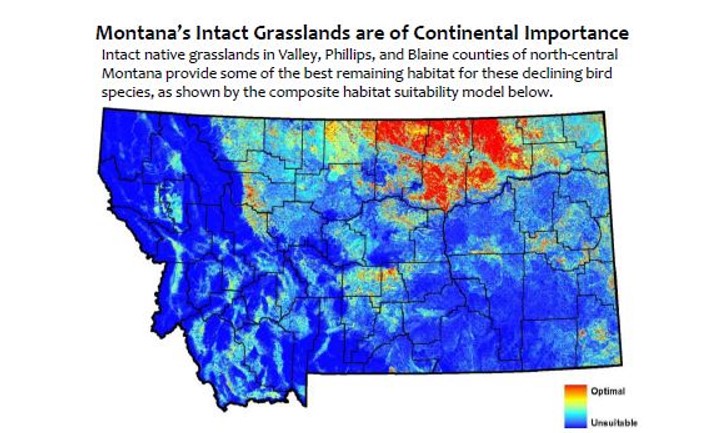Montana Ranching: An Incredible Opportunity for Bird Conservation

Image courtesy of Montana Natural Heritage Program’s Optimal Grassland Habitat Model
In 2019 Montana Audubon partnered with the National Audubon Society (NAS) to launch the Audubon Conservation Ranching Program (ACR) in Montana. To date, we’ve enrolled approximately 92,000 acres across nine bird-friendly ranches in diverse regions of the state. These ranches partner with Montana Audubon to implement adaptive Habitat Management Plans–to maintain, create, and enhance bird habitat. This is critical work, due to the fact that grassland birds are imperiled.
Current research shows grassland birds as declining and at-risk; with approximately 70% of grassland birds, like the Long-billed Curlew, Baird’s Sparrow, Burrowing Owl, Sprague’s Pipit, and Chestnut-collared Longspur, suffering massive declines (NAS; Cornell Lab of Ornithology; USFWS). Habitat degradation occurs through land conversion and fragmentation, poor grazing practices, invasive plants, pesticide use, and energy development. With only 40% of America’s Great Plains still intact, Montana ranches, with vast rangelands for cow-calf production, become pivotal in grassland bird conservation. Here are a few facts outlining the enormous scale of ranching in Montana:
- Montana is the 4th largest state in the US, comprising a total of 93.2 million acres. With 58.1 million acres in farms and ranches, 62% of Montana land is agricultural, ranking 2nd only behind Texas.
- The average Montana ranch is 2,156 acres, but can exceed 100,000 acres.
- With just over 1,000,000 human residents, cows outnumber us at 2.5 million head. Montana ranks 7th nationally in beef cattle production.
Current research also clearly shows that Montana is the “last best place” for grassland birds. Focal grassland species habitat models have explicitly identified central and eastern Montana as optimal grassland habitat, especially in Valley, Phillips and Blaine counties of north-central Montana (MNHP; Bird Conservancy of the Rockies). I have personally observed some of this species richness, having walked a single Spring prairie, enjoying the tinkling of Chestnut-collared and Thick-Billed Longspurs and Horned Larks, the rich, plaintive songs of Western Meadowlarks and Vesper Sparrows, the rising “cur-lee” alarm calls from Long-Billed Curlews, the bark of a Short-eared Owl, the shadows of Swainson’s Hawks kettle-ing in the thermals, and the descending song of a Sprague’s Pipit from far overhead.

Imagine if every Montana ranch was “bird-friendly”? Not only would grassland birds and other wildlife find refuge in our state, but the ranching community would profit from functioning ecosystems and healthier cattle. The Audubon Conservation Ranching (ACR) approach encourages ranchers to innovate, diversify their landscape, and enhance wildlife habitat. Enrolled ranches operate under a Habitat Management Plan (HMP), which provides technical guidance on regenerative grazing, non-chemical pest control, invasive species management, and infrastructure projects. ACR certification demonstrates to consumers, through the ACR seal, a rancher’s commitment to provide sustainably produced meat.
Large-scale conservation is not easy. It takes commitment, communication, and collaboration among other things. It is inspired by opportunity, and motivated by something worth saving. With the enormous scale of Montana rangelands, and with a willingness to innovate, Montana cattle ranchers have an incredible opportunity to conserve a way of life, for man, bird and beast.